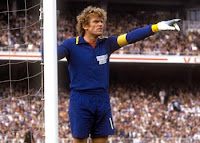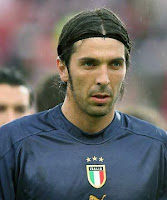The Goalkeeper
I ndubbiamente il ruolo del portiere è quello che si è meno evoluto sin dalla sua nascita. La scuola Europea (in particolare quella italiana e tedesca) è quella che, più di ogni altra, è rappresentata da portieri illustri e significativi. Per oltre 80 anni il portiere (in inglese " goal keeper ", ovvero guardiano della porta) non è altro che un palo piantato davanti alla porta, il cui unico compito è that of not letting the ball into the net
 Undoubtedly, the role of the goalkeeper is the one that is less evolved since its inception. The school European (especially German and Italian) is that, more than any other, is represented by prominent and significant goalkeepers. For over 80 years the port (in English " goal keeper ", or guardian of the door) is nothing but a pole planted at the door, whose sole task is not bring the ball into the net. It is unlikely to see out on the corners, or outside in one against a child. He has even forbidden to move beyond the goal line. Only 80 years after the goalkeeper becomes "officially" also the first defender on the team, able to move wisely outside the poles as needed.
Undoubtedly, the role of the goalkeeper is the one that is less evolved since its inception. The school European (especially German and Italian) is that, more than any other, is represented by prominent and significant goalkeepers. For over 80 years the port (in English " goal keeper ", or guardian of the door) is nothing but a pole planted at the door, whose sole task is not bring the ball into the net. It is unlikely to see out on the corners, or outside in one against a child. He has even forbidden to move beyond the goal line. Only 80 years after the goalkeeper becomes "officially" also the first defender on the team, able to move wisely outside the poles as needed.
 |
Zamora in one of its outputs
reckless |
If we analyze the history of football, however, , you may notice that there are two names that have brought a breath of fresh air. The first is English Ricardo Zamora , a true national leader of the Iberian Espanyol between years 30 and 40. Ricardo is remembered as the first pioneer of the modern goalkeeper: adventure is often, quite unconsciously, out of the stakes.
Exits often clashing with the attacker off guard or on the corners to grab the ball in flight. Iberia is also regarded as the strongest and most skilled goalkeeper before the war, a kind of legendary figure. Some twenty years later another door, this time South American and resumed the following characteristics: Amadeo Carrizo . Goalkeeper of River Plate, Amadeo is remembered as one of the strongest goalkeepers Argentina and, most importantly, innovators of all time: strong outputs in high or low as he is almost forced to play free in a super-team offensive attack and voted as the River Plate in those years, the famous "Maquina".
This role has had many famous actors over the decades. I've chosen a few:
 |
| Beautiful Yashin diving. |
The first is undoubtedly the Soviet Lev Yashin , a real legend. Only goalkeeper in football history to win a gold ball and the military in any all-time team of all time, was a goalkeeper Lev extraordinary from every point of view and, above all, complete. Equipped with exceptional reflexes, has an imposing physique and agile and a great ability to block even the most difficult balls. Lev has gained its fame thanks to his extraordinary leadership skills and coolness, so that he was accused of literally mesmerize opposing players. Pararigori strong outing and the Soviet Union also has a reference to powerful and precise positioning of a specimen on the goal line and is also a skilled communicator.
 |
| Stunning parade Dane Schmeichel |
to follow suit the Soviet choose one of my childhood myths : Peter "The Great Dane" Schmeichel, Danish giant real driver of the Danish national winner of EURO '92 and Manchester United in the mid 90's. Goalkeeper modern in every respect, Schmeichel is a true giant of 192 x 93 kg, with two huge shoulders and great physical strength. Despite the physical but the Dane has an amazing agility and lightning shots even when stationary, which is usually biased as a player with that amount. Peter is an eccentric goalkeeper, brave, almost "crazy" if you will, and this attitude is clear in his reckless outputs (both high and low), which is certainly one of the most illustrious. It throws almost always advance with extraordinary sense of timing and the ball literally to eradicate the foot (or head) of attacking opponents, almost scared dall'accorrere indomitable this blond giant. Peterone also has insane reflexes, a good positioning and a long extension of both her hands with his feet. Strong personality often had problems with coaches and other players, but his exuberance did not compromise an outstanding career full of personal recognition.
The third door that I take into account is an Italian: Gianluigi Buffon . Precocious talent, is a goalkeeper Gigi has a natural inborn talent. Initially it is a very dynamic and agile goalkeeper, without fear, without fear that jumps between feet of the opponent, and that makes exceptional reflexes and intuition of its strength. Over the years, however Buffon change his style of play is pretty sure a goalkeeper in goal, made no mistake and almost never makes the efficiency and consistency of his greatest quality, has excellent reflexes, is strong in the output has tactically and physically, is also a leader in the field and a funny guy out. It is loved by everyone, fans and non fans. His only weak point, so to speak, is that of penalties. Gigi has never been a big pararigori like Yashin or Schmeichel ... but we are sure that if it was undoubtedly would have been considered the strongest goalkeeper ever. Other notable examples of this role in addition to those cited: Ladislao Mazurkiewicz, Uruguay's goalkeeper of Polish origin, the Soviet Rinat Dasaev, Ubaldo Fillol the Argentine, Brazilian Gilmar, the German Sepp Maier and Oliver Kahn, the Italians Dino Zoff, Walter Zenga, the Yugoslavian Frantiseck Planicka, the British Gordon Banks and Peter Shilton. Goalkeepers modern worthy of mention: English Iker Casillas, Czech Peter Cech and Brazilian Julio Cesar.
[Goalkeepers Significant]
- Lev Yashin (USSR) The strongest goalkeeper of all time. Imposing physically, agile, great communicator, great reflexes and tactical skills, much pararigori. First and only goalkeeper in football history to win a gold ball
- ; Gianluigi Buffon (Italy). While games still is now considered the strongest of the sacred monster Zoff. Goalkeeper incredibly continuous, very wrong, great reflexes and leadership skills. Touched her winning the Golden Ball in 2006 after a dazzling world.
- Ricardo Zamora (Spain). One of the first to transform the role of the goalkeeper. Goalkeeper brave, almost reckless, a charismatic, reflexes and acrobatic skills.
 |
| Close up of Dino Zoff. |
- Peter Schmeichel (Danimarca). Il gigante biondo è considerato uno dei portieri più forti di sempre. Imponente fisicamente e molto agile, fortissimo nelle uscite alte o basse, riflessi eccezionali, buone doti di posizionamento e carisma eccezionale. Fu colonna portante della nazionale danese campione d’Europa (1992) e dello United.
- Dino Zoff (Italy). Example of competitive longevity and great professionalism. E ', after Buffon, the Italian goalkeeper stronger than ever. Extraordinary means tactical mistakes and is always very cold in front of the strikers, can remain at high levels until old age.
- Gordon Banks (England). Author of the "Parade of the Century" on the sample Pele, is a goalkeeper for exceptional charisma and technical means. Great reflexes, positioning skills and charisma, is the English goalkeeper stronger than ever.
- Gilmar (Brazil). Experts considered the strongest South American goalkeeper ever, was a player very quick and agile in goal, with feline reflexes and jumps. Surely the Brazilian goalkeeper stronger than ever.
- Ladislao Mazurkiewicz ( Uruguay). Portiere uruguagio di evidenti origini polacche, è, dopo Gilmar, uno dei portieri sud-americani più talentuosi in assoluto. Grandissime doti di freddezza e di carisma tra i pali davano l’impressione che fosse quasi imbattibile. Portiere molto sottovaluto ma considerato tra i più forti di sempre come doti naturali.
- Frantisec Planicka ( Cecoslovacchia). Autentica colonna dello Slavia Praga e della Cecoslovacchia è considerato, insieme a Zamora e Combi, uno dei portieri più forti dell’anteguerra. Portiere estremamente agile tra i pali è diventato famoso per la straordinaria capacità di bloccare anche i tiri più insidiosi, nonché per il grande coraggio e carisma.
- Giampiero Combi (Italia). Portiere piccolo, con muscolatura esplosiva e tonica, dotato di riflessi felini e di un balzo prodigioso, era noto per la spericolatezza delle uscite e per i grandi riflessi.
- Sepp Maier (West Germany). Goalkeeper Bayern Monaco and winning the big 70's and the German national team. Eccentric and extravagant personality was an agile goalkeeper with excellent reflexes and a strong outing. With Germany goalkeeper Oliver Kahn one of the best ever.
 |
| Sepp Maier gives orders to his defense |
- Michel Preud'homme (Belgium). Product of the Belgian school is considered one of the best goalkeepers in the 90s. Physical agility and sleek, irreverent and lively personality, great reflexes and concentration.
- Jean-Marie Pfaff (Belgium). Another great product of the Flemish school. Most physically imposing of compatriot Preud'homme, Pfaff excelled on the high balls, in command of the small and also block the ball more insidious. He, like Preud'homme, with an eccentric personality
- ; Peter Shilton (England). Goalkeeper serious, reliable, professional and very durable. He played until almost 45 years, showing excellent technical skills / tactics and Britain and was one of the most complete and reliable goalkeepers ever.
- Oliver Kahn (Germania). Da molti considerato addirittura migliore di Sepp Maier, Kahn è stato un portiere grintoso, determinato, considerato giustamente uno dei migliori portieri del mondo nella seconda metà degli anni 90. E’ un portiere dal fisico imponente, dal carattere forte ed autoritario e da ottimi mezzi tecnici.
- Rinat Dasaev (USSR). Portiere della degli Anni 80 Soviet school dotates di agiliti, destrezza, great Doti says comunicazione ed eccezionale riflessi.
portieri Altri motivi per non Citati Spazio says: Edwin Van Der Sar; Ubaldo Fillol, Andoni Zubizarreta, Thomas Ravelli, Walter Zenga, Enrico Albertosi, Vitor Baia, Alberto Costa, Thomas N'Kono, Jacques Songo'o, Andreas Kopke, Rudi Hiden, Bodo Illgner, Toni Schumacher, Bert Trautmann, Vladimir Bear, Gyula Grosics, Jose Luis Chilavert, José Angel Iriba, Jan Tomaszewski, Ivo Viktor, etc
 " Munoz-Moreno-Pedernera-Labruna-Lostau . These five names, repeated as a kind of litany, are familiar to any fan of River Plate, a bit 'like the local "S Burgnich-arts-Facchetti ", so to speak. Names that evoke fond memories: images of a great team of the past that made the fans dream of Argentina, and more ...
" Munoz-Moreno-Pedernera-Labruna-Lostau . These five names, repeated as a kind of litany, are familiar to any fan of River Plate, a bit 'like the local "S Burgnich-arts-Facchetti ", so to speak. Names that evoke fond memories: images of a great team of the past that made the fans dream of Argentina, and more ... 
























